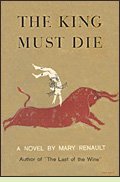|
The King Must Dieby Mary RenaultReviewed by David Maclaine
These rich themes give the novel its weight and texture, but the core of the tale is a great adventure that combines popular genres of heroic resistance and rebellion with those of the sport novel. Renault melds the original legend of sacrificial victims and a deadly labyrinth with the images of acrobatic bull-leaping found in Minoan art. Theseus’ triumph in the Knossos of King Minos is linked to the evergreen story of a group of young people forged into a team in order to triumph in an athletic event. The King Must Die was the first Renault novel I ever read, and thanks to its blend of vivid action and the artful evocation of a very different culture it remains my favorite. (1958, 332 pages) More about The King Must Die at Powell's Books, Amazon.com The King Must Die appears on the list of The 36 Best Historical Novels for a Survey of Ancient Greek History The Sea Kings: The Prophecy by Les Cole (1996), about Cretan traders in the Bronze Age; #1 in a trilogy. More info Pasiphae by Peter Huby (2000), based on the Greek myth about Pasiphae, which tells how the Minotaur came to exist. More info Voice of the Goddess by Judith Hand (2001), about a woman and her lover in ancient Crete during a time of invasion and the volcanic eruption that destroyed the nearby island of Santorini. More info
The Civilization of Ancient Crete by R.F. Willetts (1992). More info Minoan Life in Bronze Age Crete by Rodney Castleden (1990). More info Knossos: A Complete Guide to the Palace of Minos by Anna Michailidou (2004), a travel guide for visitors to the ruins of the palace where Theseus is supposed to have encountered the Minotaur. More info
Knossos at Sacred-Destinations.com
Back to Novels of Ancient History
|
